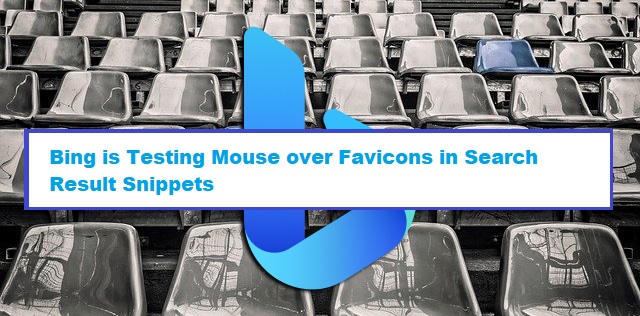Bing is Testing Mouse over Favicons in Search Result Snippets
Whenever you search anything on Google, you hover the cursor over different search results that appear on the page, right. You all know that Google shows favicons with each search result snippets over the title. What about users using Bing as their search engine? Do they get to see any favicon icon in search results snippets? Presently, Bing doesn’t show any favicon icons to users. Well, this makes the search results fade and not eye-catching. But the good thing is that Bing is doing something interesting which will make user experience enhancing in one search. Let me tell you that Bing is testing mouse over favicons in search results snippets that will benefit digital marketers. Sounds interesting no?

Wanna know about the new testing of Bing in detail? If yes, keep reading the article till the end. Don’t try to skip the article otherwise, you will miss the important information.
Let’s jump into the Bing update below.
Bing to test mouse over favicons in search results snippets
On 9 September, a charming user interface test comes from Bing where you get to see favicons over search results snippets. Yes, Bing soon will show you favicons appearing in search results. The person who saw this testing feature is Frank Sandtmann. He shared the details of the Bing testing feature with Barry Schwartz, founder of the SEround table. He did not share the details on Twitter.
What Frank Sandtmann shared with Barry Schwartz? He basically made a GIF of search results hovering mouse over search results snippets. And the GIF you can see on SEround table where you need to click on the picture.
How will you get to see favicon icons in search results snippets?
While performing search on Bing, all you need to do is hover your mouse cursor over the title of a search result snippet. It will show you the favicon of the site on the left side of that title.
Well, there is no confirmation when Bing will make this feature available for its users. And we also can’t give you guarantee that if you do research now you will get to see the favicon icons.
Since this article is all about Bing and snippets. Why not talk about this in details so that you also gain knowledge, right?
Let’s start digging below.
The ultimate concept of snippets
Put simply, snippet is a short description from the webpage of your website. It is a description which follows your webpage title and precedes the URL and Cached links. So yes, it refers to the descriptive portion of a Google search listing or Bing search listing.
What is the aim of snippet? The sole aim of snippet is to emphasize the content on a page that best links to a user’s specific search. So these snippets are generated based on the search term and are presented as part of a search result list.
Now that you have understood the concept of snippets, now there are two terms which often used interchangeably. These two terms are-
- Rich snippets
- Rich result
Are these two terms really similar or there is any difference between them? Below read the definition of these two.
Rich Snippets
Rich snippet refers to regular search results with additional information shown along with the title, descriptive snippets, and URL. This snippet gets higher click-through rates. It is because people only prefer to click on the results that give them more information. The more the click-through rate will be, the higher amount of traffic digital marketers, webmasters, and SEOs will get on their site. Moreover, rich snippets do not have any direct impact on your rankings. But it can surely generate indirect SEO benefit by making your page more indexable and giving more accurate metadata.
Rich Results
On contrary, Rich Results refers to any type of visually-appealing and enhancing search results with information derived from relevant structured data. So you can say that Rich Results are type of rich snippets. Additionally, an enhanced result in Google search with extra visuals or interactive features. Earlier, rich results were known as ‘rich cards’ or ‘rich snippets.’
Let’s move further and talk about Favicon.
What is favicon?
Favicon is a tiny image of a brand that helps users locate brand’s page easily on search engine. In other words, a favicon is a small 16×16 pixel icon that serves as branding for your website. The main purpose of favicon is to help visitors locate your page easier when they have multiple tabs open. Favicons work best due to their tiny size or simple images or one-to-three characters text.
You should not associate favicon with logo because both are different and people easily get confused with these two.
How helpful favicons are for brands?
No doubt, favicons are very small in size but they are helpful and important for brands. Favicon adds legitimacy to your site and helps grow your online branding as well as trust from potential customers. In fact, favicon easily catches the attention of your visitors. Your visitors get quick identification for web with favicon icons. Here read the points on importance of favicon:
- Favicon helps marketers establish credibility
- Online marketers can easily build their brand awareness
- Your website becomes more visible in web world.
Concluding note
Favicons are very important for online marketing. Till now Google shows favicon icons on search result snippets but Bing is also testing favicons over search results. Well, there is no confirmation when Bing will make favicon appearance available, only testing is going on as of now. If any update comes from Bing about favicon icons, we will let you know.
Till then keep reading and sharing our articles and don’t forget to Subscribe to our website.


